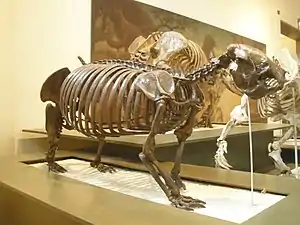Megalocnus
Megalocnus ist ein ausgestorbenes Faultier aus der Überfamilie der Megalocnoidea. Die Gattung lebte während des Pleistozän und Holozän auf den Karibischen Inseln und starb erst vor etwa 6000 Jahren aus. Die größte Art Megalocnus rodens aus Kuba war zugleich das größte karibische Bodenfaultier und erreichte vermutlich ein Körpergewicht von etwa 200 kg. Die letzten Funde dieser Art werden auf ein Alter von etwa 6000 Radiokohlenstoffjahren datiert.[1] Eine weitere Art der Gattung ist Megalocnus zile aus dem Quartär von Hispaniola.[2]
| Megalocnus | ||||||||||||
|---|---|---|---|---|---|---|---|---|---|---|---|---|

Skelett von Megalocnus rodens | ||||||||||||
| Systematik | ||||||||||||
| ||||||||||||
| Wissenschaftlicher Name | ||||||||||||
| Megalocnus | ||||||||||||
| Leidy, 1868 |
Einzelnachweise
- D. W. Steadman, Martin, P. S.; MacPhee, R. D. E.; Jull, A. J. T.; McDonald, H. G.; Woods, C. A.; Iturralde-Vinent, M.; Hodgins, G. W. L.: Asynchronous extinction of late Quaternary sloths on continents and islands. In: National Academy of Sciences (Hrsg.): Proc. Natl. Acad. Sci. USA. 102, Nr. 33, 16. August 2005, S. 11763–11768. doi:10.1073/pnas.0502777102. PMID 16085711. PMC 1187974 (freier Volltext). Abgerufen am 24. Januar 2009.
- R.D.E. MacPhee, Jennifer L. White, Charles A. Woods: New Megalonychid Sloths (Phyllophaga, Xenarthra) from the Quaternary of Hispaniola. American Museum Novitates Oct 2000 : Number 3303, pg(s) 1-32 (2000).
Weblinks
Commons: Megalocnus – Sammlung von Bildern, Videos und Audiodateien
This article is issued from Wikipedia. The text is licensed under Creative Commons - Attribution - Sharealike. The authors of the article are listed here. Additional terms may apply for the media files, click on images to show image meta data.